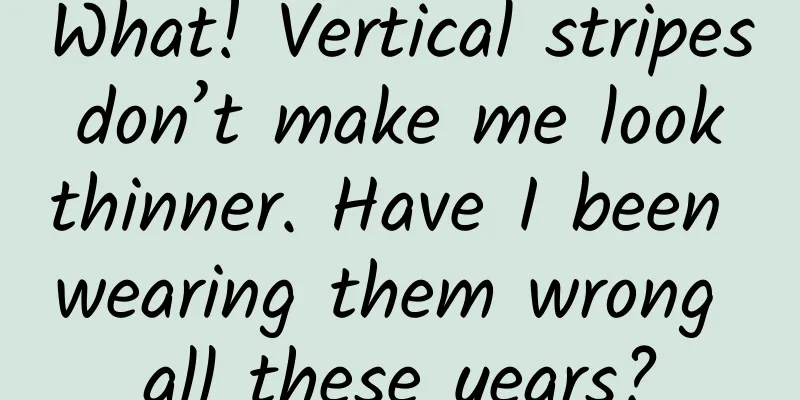What! Vertical stripes don’t make me look thinner. Have I been wearing them wrong all these years?

|
Summer is here, and it’s time for everyone to “show off their figures”. In addition to eating less and exercising more, wearing the right clothes can be considered the fastest way to lose weight! So what kind of clothes are the most suitable? Let me give you the answer first: dark-colored clothes and clothes with horizontal stripes (yes, horizontal stripes, not vertical stripes). Next, let's talk about the reasons from the two aspects of color and stripes~ 01 Black makes you look thinner Both dressing advice and daily experience tell us that wearing black clothes makes you look thinner. Can black really make you look thinner? This was confirmed in a 2021 study published in Acta Psychologica. In this study, researchers used computers to generate two groups of pictures of people wearing different colored clothes, one group was slender and the other was plump, and then asked 31 women to rate the people in the pictures in terms of attractiveness, body shape, etc. (All the judges were women, probably to avoid experimental errors caused by men's straight aesthetics!) Women wearing clothes of different colors, you can also take a look at which clothes you think are more "slimming"? Image source: Sidhu et al., 2021 The results showed that for both slim and plump people, wearing black, blue and red clothes made them look thinner than their actual body shape. Among these three colors, the “slimming effect” is: black>blue>red. In contrast, gray, green, and white clothes are more “fat-making”. The fat-making effect is: white>gray>green[1]. In order to eliminate the influence of the skin color of white models, the research team also used black models for testing, and the results were the same. So, black does have a good slimming effect. Of course, the study also found that both men and women think that women wearing red clothes are more attractive. So red and black clothes have higher attractiveness ratings. In contrast, green and gray clothes have lower attractiveness ratings. 02 Dark clothes make you look thinner Although life experience and psychological experiments have confirmed that black makes people look thinner, why does black have such an effect? The reason behind this is the "radiation illusion", and the radiation illusion tells us that except for black, dark-colored clothes can make you look thinner. Copyright images in the gallery. Reprinting and using them may lead to copyright disputes. The story of the irradiation illusion begins more than 400 years ago. More than 400 years ago, when Galileo di Vincenzo Bonaulti de Galilei was observing the starry sky, he discovered a magical phenomenon - white makes people look fatter. Of course, it is not people who look fatter, but the stars. Galileo discovered that Venus looks larger than Jupiter when viewed with the naked eye, but if you do some calculations you will find that this is not the case. Considering the sizes of Venus and Jupiter and their distances from Earth, Jupiter actually occupies a larger area in the sky than Venus. But in the period when Galileo lived, the research on vision was not in-depth, and Galileo could only make a guess that this might be related to the refraction and scattering of light when it passes through the lens of the eye. More than 200 years later, the great German scientist Hermann von Helmholtz tackled this problem. Helmholtz believed that the key to the problem should not be the lens, because whether it is bright light or dim light, the deformation produced when they pass through the lens should be the same. Helmholtz believed that the key to the problem should be the visual nervous system. Helmholtz formally described this phenomenon and his conjecture in his paper "Physiological Optics" and named this phenomenon "irradiation illusion". In recent years, scientists have finally confirmed that the "irradiance illusion" is indeed related to the way the visual nervous system processes information. Dark stimuli can accurately reflect the size of an object, but bright stimuli will produce exaggerated neural signals, which makes bright spots against a dark background appear larger. Conversely, black spots against a bright background will also appear smaller because the surrounding bright background will appear larger than it actually is [2]. "Irradiance illusion", white (bright) squares appear larger than black (dark) squares. Image source: wikimedia Because of the "irradiation illusion", we feel that the sizes of the black and white grids in the figure are inconsistent, but in fact they are the same. Image source: Westheimer G, 2008 Based on the principle of "irradiation illusion", it is easy to explain why black clothes make people look thinner. Black clothes will appear smaller than their actual size against a bright background. Even in an environment with dim background light, black clothes will only reflect the size of your body and will not make you look fatter. On the contrary, white clothes will make your body look bigger in an environment with dim surrounding light. Of course, the irradiance illusion is not limited to black and white, but to light and dark. Other dark-colored clothes can also have a certain slimming effect (such as blue and red in the previous study). 03 Horizontal stripes make you taller and thinner In addition to black, in daily life, many people think that wearing vertical striped clothes can also make them look thinner. But in 1867, Helmholtz wrote about many optical illusions in everyday life, including that “a girl in a horizontally striped dress appears taller”[4]. To test this illusion, Helmholtz compared two squares of the same size but with different stripes. He found that the square with horizontal stripes appeared taller than the area with vertical stripes (see the image below). Helmholtz illusion: Squares with horizontal stripes appear taller than those with vertical stripes. In 2011, an article also studied the visual effects of horizontal and vertical stripes in detail. First, they changed cartoon characters into horizontal and vertical striped clothes and asked people to judge the body shapes of the two people. The results showed that people thought that girls wearing vertical stripes were about 6% fatter than those wearing horizontal stripes.[5] But there are opponents who believe that horizontal stripes only make people look taller in two-dimensional planes, but vertical stripes make people look thinner in real three-dimensional space. However, the research team also confirmed that in three-dimensional space, horizontal stripes still make people look thinner, and the slimming effect is even more obvious. The researchers built a three-dimensional human model and dressed it in clothes with horizontal and vertical stripes. The results showed that the subjects thought that people with horizontal stripes looked thinner and 10% thinner than those with vertical stripes.[5] Therefore, all the evidence shows that Helmholtz's conjecture was correct. 3D human body model, do you think horizontal stripes make you look thinner or vertical stripes make you look thinner? Therefore, the conclusion is clear. The saying that "vertical stripes make you look thinner" is not reliable. Scientific research stands on the side of horizontal stripes. Next time you see horizontal striped clothes, you might as well try it. It may surprise you! References: [1] Sidhu N, Qualter C, Higgs E, et al. What color should I wear? How clothing color affects women's judgment of other women's body attractiveness and body size[J]. Acta Psychologica, 2021, 218: 103338. [2] Kremkow J, Jin J, Komban SJ, et al. Neuronal nonlinearity explains greater visual spatial resolution for darks than lights[J]. Proceedings of the National Academy of Sciences, 2014, 111(8): 3170-3175. [3] Westheimer G. Illusions in the spatial sense of the eye: Geometrical–optical illusions and the neural representation of space[J]. Vision research, 2008, 48(20): 2128-2142.) [4] Helmholtz H v. Treatise on Physiological Optics. Vol. 3. New York: Dover; 1867/1962. 1962. [5] Thompson P, Mikellidou K. Applying the Helmholtz illusion to fashion: horizontal stripes won't make you look fatter[J]. i-Perception, 2011, 2(1): 69-76. Author: Science scraps popular science team Reviewer: Tang Yicheng, Deputy Director of Beijing Zhongke Popular Psychological Health Promotion Center Planning Editor: Xu Lai Editor in charge: Yinuo The cover image and the images in this article are from the copyright library Reprinting may lead to copyright disputes |
<<: Come and learn! Doing these exercises more often can prevent cervical spondylosis
>>: Popular Science Illustrations | Smart Agriculture Helps Watermelon "Upgrade Its Sweetness"
Recommend
Pilates Li Xin Pilates Control
: : : : : : : : : : : : : : : : : : : : : : : : : ...
ZF and Hella reach strategic cooperation to pave the way for autonomous driving
At 17:00 on June 20, local time in Slovakia, ZF F...
A brief discussion on performance optimization in Android
Performance optimization is a big topic. If someo...
Surprise! The "supermoon" will be here for the Mid-Autumn Festival. This year, you can "feast your eyes"
The bright moon rises over the sea, and the world...
How to create a WeChat mini program for selling vegetables? How to sell vegetables through WeChat mini program?
Today's industries are diverse, and many new ...
How many of the App Store's super exposure positions have you managed to hold?!
Currently, China has become the second largest iP...
After this year's Spring Festival, will we miss New Year's Eve for five consecutive years? It's all because of the "moon"
#There will be no New Year's Eve for 5 consec...
27 provinces have resumed passenger routes! Will there be any impact on epidemic prevention and control? Attached is the specific list!
At present, except for Hubei Province, the epidem...
APP operation: How to operate the four life cycles of a product
Having been engaged in operations for so long, I ...
Station B Operation: Detailed analysis of Station B’s membership system!
On October 10, 2016, Bilibili launched the B-stat...
Can fried oil really not be reused multiple times? The answer is not what people think
People who like to eat snacks should have seen fr...
Uncovering the technical principles of the "Star Wars" robot BB-8
This should be one of the most watched non-human ...
2.53 meters! When people in Shandong say you are "not even as tall as a green onion", they are not kidding you.
I'll give you a riddle: It doesn't grow b...
Wuhan high-end tea tasting club takeaway tea sn most reliable contact information
Wuhan high-end tea tasting consultation 132-7243-...
Lu Qi manages Baidu's all-in AI strategy Baidu's overall strategy for artificial intelligence
199it News July 5, 2017, is perhaps the most impo...









